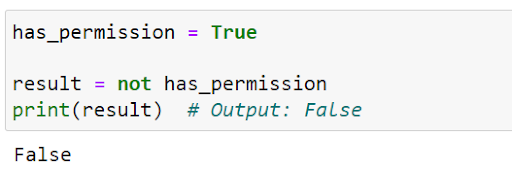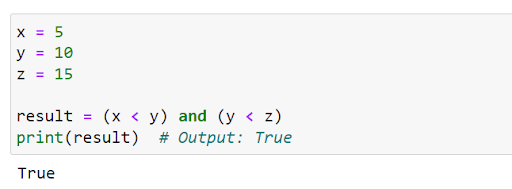Logical operators in Python (or, not, and)
Published by
sanya sanya
Introduction:
Logical operators are an essential part of programming, enabling us to perform complex decision-making and control flow in our code. In Python, we have three primary logical operators: or, not, and and. In this blog post, we will dive deep into each of these operators, understand their functionality, and explore practical examples to solidify our understanding.
The or Operator:
The or operator returns True if any of the operands (expressions) it connects is True. It evaluates expressions from left to right and stops as soon as it finds a True value. If all expressions evaluate to False, it returns False. Let's explore some examples:
Example 1:

In this example, (x < y) evaluates to True, and the or operator stops there, returning True.
Example 2:

In this case, all expressions evaluate to False, resulting in the or operator returning False.
The not Operator:
The not operator performs logical negation, meaning it reverses the truth value of the operand. If the operand is True, not returns False, and if the operand is False, not returns True. Let's examine some examples:
Example 1:

Here, is_raining is False, but the not operator negates it, resulting in True.
Example 2:

In this case, has_permission is True, but the not operator changes it to False.
The and Operator:
The and operator returns True if all of the operands evaluate to True. It evaluates expressions from left to right and stops as soon as it encounters a False value. If all expressions are True, it returns True. Let's explore some examples:
Example 1:

In this example, both (x < y) and (y < z) evaluate to True, so the and operator returns True.
Example 2:

In this case, all expressions are True except is_student, which is False. Thus, the and operator returns False.
Conclusion:
Logical operators (or, not, and and) play a vital role in controlling program flow based on conditions. Understanding their functionality is crucial for writing robust and expressive code. In this blog post, we explored the behavior of each operator with detailed examples and highlighted their usage in different scenarios.
Here's a recap of what we covered:
The or operator:
Returns True if any of the connected expressions is True. Stops evaluation when it encounters the first True value. Returns False if all expressions evaluate to False.
The not operator:
Performs logical negation by reversing the truth value of the operand. Returns True if the operand is False. Returns False if the operand is True.
The and operator:
Returns True if all connected expressions are True. Stops evaluation when it encounters the first False value. Returns False if any expression evaluates to False.
By combining these logical operators with conditional statements, loops, and other control flow mechanisms, you can create sophisticated decision-making logic in your programs.
To further solidify your understanding, here are a few additional examples:
Example 1: Combining or and not operators

In this case, not is_weekend evaluates to False, but is_holiday is True. However, since we are using the or operator, the overall result is still True.
Example 2: Complex combination of logical operators

Here, the expression (num > 10) and (num % 2 == 0) evaluates to True, and the or operator combines it with (num < 25), which also evaluates to True, resulting in the overall result of True.
Logical operators provide flexibility in controlling program behavior based on different conditions. Understanding their behavior and effectively utilizing them can lead to more efficient and concise code.
In conclusion, logical operators (or, not, and and) are fundamental tools for decision-making and control flow in Python. By applying these operators correctly, you can create dynamic and logical programs that adapt to different scenarios. I hope this blog post has provided you with a detailed understanding of these operators and how to use them effectively in your Python code.
Library
WEB DEVELOPMENT
FAANG QUESTIONS
On this page
Introduction:
Conclusion:

